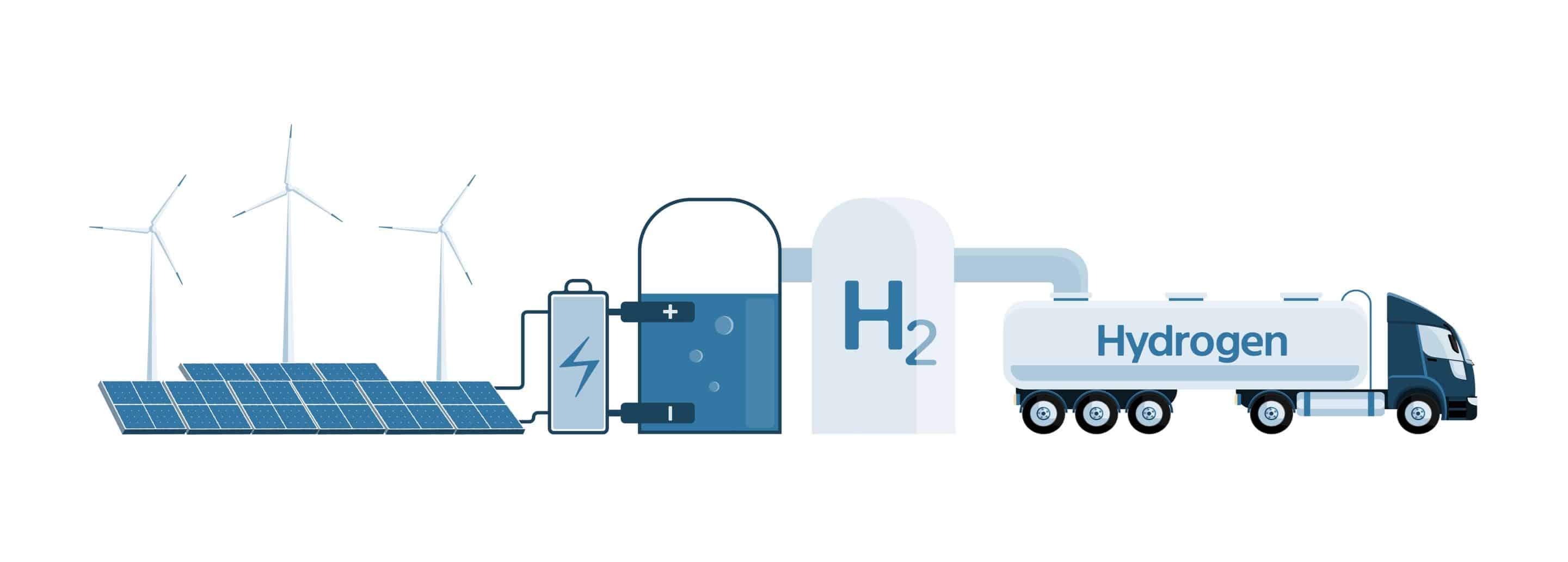Green hydrogen systems are emerging as game-changers in the realm of sustainable energy. As concerns grow over climate change and dependence on fossil fuels, green hydrogen offers a promising alternative for a low-carbon future. Let’s explore the potential of green hydrogen systems, how they work, and their implications for the energy sector.
Green Hydrogen: A Clean Energy Solution
Green hydrogen is produced through a process called electrolysis, which uses renewable energy sources like solar or wind power to split water molecules into hydrogen and oxygen. Unlike traditional hydrogen production methods that rely on natural gas, green hydrogen is a carbon-free fuel source with a minimal environmental impact.
Benefits of Green Hydrogen Systems
- Environmental sustainability: Green hydrogen production generates zero greenhouse gas emissions, making it a clean and eco-friendly alternative to fossil fuels.
- Energy storage: Green hydrogen can be stored and transported, allowing excess renewable energy to be captured and used later when needed.
- Versatility: Green hydrogen can be utilized in various sectors, including transportation, power generation, and industrial processes.
Green Hydrogen Generators: Turning Renewable Energy into Hydrogen
A vital component of green hydrogen systems is the green hydrogen generator, which uses electrolysis to produce hydrogen from renewable energy sources. There are different types of electrolyzers available, each with its advantages and drawbacks. Among the most common types are proton exchange membrane (PEM) electrolyzers and alkaline electrolyzers.
Proton Exchange Membrane (PEM) Electrolyzers
PEM electrolyzers are known for their high efficiency and rapid response to changes in electricity supply. They are well-suited for integration with renewable energy sources like wind-powered hydrogen generators, making them a popular choice for green hydrogen production.
Alkaline Electrolyzers
Alkaline electrolyzers have been used for decades and are a more established technology compared to PEM electrolyzers. Although they have lower efficiency and slower response times, alkaline electrolyzers are often more cost-effective and can be scaled up for large-scale hydrogen production.
The Role of Green Hydrogen in the Energy Transition
Green hydrogen systems play a crucial role in the ongoing energy transition as the world moves towards renewable and sustainable energy sources. Some of the key areas where green hydrogen can make a significant impact include:
- Transportation: Green hydrogen can be used to fuel hydrogen-powered vehicles, reducing emissions in the transportation sector.
- Power generation: Green hydrogen can be converted back into electricity using fuel cells or burned in turbines to generate power, offering a flexible and dispatchable energy source.
- Industrial processes: Green hydrogen can replace fossil fuels in various industrial processes, such as steel production and ammonia synthesis, contributing to a more sustainable and low-carbon economy.
As green hydrogen systems continue to develop, they hold the potential to transform the energy landscape and pave the way for a cleaner, more sustainable future. By investing in innovative technologies and integrating green hydrogen into existing infrastructure, we can accelerate the transition to a low-carbon, renewable energy-driven world. Learn more about the latest developments in green hydrogen and sustainable energy solutions here.
Green Hydrogen Storage and Distribution
As the adoption of green hydrogen systems increases, efficient storage and distribution methods become essential to ensure a reliable and steady supply of hydrogen. Here are some of the most common methods used to store and distribute green hydrogen:
Compressed Hydrogen
Green hydrogen can be compressed and stored in high-pressure tanks, usually at pressures between 350 and 700 bar. Compressed hydrogen is widely used in transportation applications, such as fuel cell vehicles, and can be transported via trucks or pipelines.
Liquid Hydrogen
To store hydrogen in its liquid form, it must be cooled to extremely low temperatures (-253°C or -423°F). Liquid hydrogen has a higher energy density than compressed hydrogen, making it suitable for long-term storage and transportation. However, the energy-intensive cooling process and potential for boil-off losses during storage are significant drawbacks.
Ammonia and LOHCs
Alternative methods for hydrogen storage and transportation involve converting hydrogen into other chemical forms, such as ammonia or Liquid Organic Hydrogen Carriers (LOHCs). These methods allow hydrogen to be stored at lower pressures and temperatures, reducing the energy requirements for storage and transportation. However, additional conversion processes are necessary to extract the hydrogen before use, which can impact overall efficiency.
The Future of Green Hydrogen Systems
The potential of green hydrogen systems is immense, but further research and development are needed to overcome challenges and improve the efficiency and cost-effectiveness of green hydrogen production, storage, and distribution. Some key areas of focus for future innovation include:
- Electrolyzer advancements: Improving the efficiency, scalability, and cost-effectiveness of electrolyzers is crucial to increase green hydrogen production.
- Infrastructure development: Expanding the hydrogen refueling and distribution infrastructure will facilitate the widespread adoption of green hydrogen systems in various sectors.
- Integration with renewable energy: Developing smart grids and energy storage systems that can efficiently integrate green hydrogen production with variable renewable energy sources, such as wind and solar power, is essential for a more sustainable energy mix.
Green hydrogen systems are poised to play a significant role in the global transition towards sustainable energy. By addressing the challenges and harnessing the potential of this innovative technology, we can unlock a cleaner and greener future for generations to come. For more information on green hydrogen and other sustainable energy solutions, check out this comprehensive guide.

Green Hydrogen Applications
Green hydrogen has the potential to revolutionize various sectors and industries, offering a sustainable and eco-friendly energy source. Here are some of the most promising applications of green hydrogen systems:
Transportation
Green hydrogen can be used as an alternative fuel for vehicles, reducing the reliance on fossil fuels and lowering emissions. Fuel cell vehicles powered by green hydrogen emit only water vapor and have a higher energy density than battery electric vehicles, allowing for longer driving ranges and faster refueling times. Green hydrogen is especially promising for heavy-duty vehicles, such as trucks, buses, and trains, where battery technologies may not be as practical due to weight and range limitations.
Power Generation
Green hydrogen can be used in fuel cells or turbines to generate electricity, providing a clean and flexible power source for grid-scale energy storage or remote off-grid applications. The integration of green hydrogen systems with renewable energy sources, like solar or wind power, can help stabilize the grid and ensure a steady supply of electricity, even during periods of low renewable energy generation. For example, excess renewable energy can be used to produce green hydrogen through electrolysis, which can be stored and later converted back into electricity when needed.
Industrial Processes
Many industrial processes, such as steel production, ammonia synthesis, and refining, rely on hydrogen as a feedstock or energy source. Currently, most hydrogen used in these processes is derived from fossil fuels, resulting in significant greenhouse gas emissions. Green hydrogen can replace this conventional “grey” hydrogen, reducing the environmental impact of these industries and helping them transition towards more sustainable practices.
Heating
Green hydrogen can be used as a source of heat in residential and commercial buildings, either directly through hydrogen boilers or indirectly by blending hydrogen with natural gas. This can help reduce the reliance on natural gas and other fossil fuels for heating, lowering emissions and promoting a more sustainable energy mix.
The widespread adoption of green hydrogen systems has the potential to significantly reduce greenhouse gas emissions, support renewable energy integration, and transform various industries. By investing in research, development, and infrastructure, we can unlock the full potential of green hydrogen as a sustainable energy source. For more information on green hydrogen and other energy storage technologies, explore our in-depth guide on cutting-edge battery technologies.
Challenges and the Road Ahead
While green hydrogen systems hold immense potential as a sustainable energy source, there are still challenges to overcome to make them a mainstream solution. Some of these challenges include:
Cost and Efficiency
The production of green hydrogen through electrolysis is currently more expensive than conventional hydrogen production methods, such as steam methane reforming. Improving the efficiency of electrolyzers and reducing their capital costs are essential for making green hydrogen more cost-competitive. Research and development in electrolysis technologies, like proton exchange membrane (PEM) and solid oxide electrolyzers, are key to achieving these goals.
Storage and Transportation
Storing and transporting green hydrogen can be challenging due to its low energy density and the need for high-pressure storage systems. Developing advanced storage solutions, such as metal hydrides or liquid organic hydrogen carriers, can help overcome these challenges and enable the large-scale deployment of green hydrogen systems. Additionally, investments in hydrogen refueling infrastructure are crucial for supporting the widespread adoption of hydrogen-powered vehicles.
Public Perception and Policy Support
Public awareness and acceptance of green hydrogen as a viable energy source are crucial for its adoption. Education and outreach efforts can help promote the benefits of green hydrogen systems and dispel misconceptions. Furthermore, supportive policies, such as incentives for green hydrogen production and use, can accelerate the transition towards sustainable energy solutions.
Scaling up Production
To meet the growing demand for green hydrogen, large-scale production facilities and renewable energy infrastructure must be developed. Public and private investments in green hydrogen production projects, along with the integration of renewable energy sources, will be essential for achieving the scale needed to make a significant impact on global energy systems.
The future of green hydrogen systems is bright, with numerous applications across various sectors and the potential to transform our energy landscape. By addressing the challenges and leveraging the opportunities, we can pave the way for a more sustainable and eco-friendly future. To learn more about green hydrogen systems and other innovative energy storage solutions, check out our comprehensive guide to cutting-edge battery technologies.
Green hydrogen systems have the potential to revolutionize the way we produce and consume energy, offering a sustainable and eco-friendly alternative to fossil fuels. By harnessing the power of renewable energy sources, green hydrogen can be used for a wide range of applications, from electricity generation to transportatioon and industrial processes. As we continue to develop and improve electrolysis technologies, storage solutions, and supportive policies, we can expect to see green hydrogen playing an increasingly significant role in the global energy mix.
The development and adoption of green hydrogen systems are critical to achieving a sustainable future and mitigating the impacts of climate change. By investing in research, infrastructure, and public awareness, we can overcome the challenges associated with green hydrogen production and distribution and unlock the full potential of this promising energy source.
Stay informed about the latest advancements in green hydrogen systems and other energy storage technologies by exploring our guide to cutting-edge battery technologies, and discover how you can contribute to a more sustainable and energy-efficient future.



